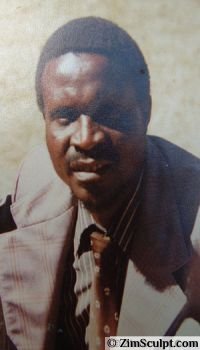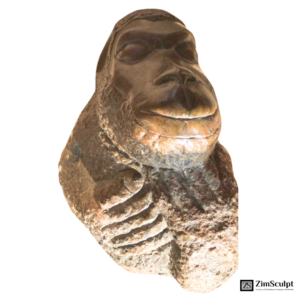Boira Mteki was born in 1946 in Harare and as one of the founder sculptors of Frank McEwen’s National Gallery Workshop School, his work has graced many of the most important exhibitions during the last thirty years. As early as 1962 he started using the hardest materials available and, by example encouraged others to move from the soft Soapstone and Steatite then predominant, to hard Serpentines, Springstone, Limestone and Granite. These demanding stones were to compliment the powerful imagery of his sculpture and as a result he was soon acknowledged by many as a ‘leader’ of the Workshop sculptors – John and Bernard Takawira, Joram Mariga, Joseph Ndandarika, Thomas Mukarobgwa and Nicholas Mukomberanwa. He is perhaps best known for his monumental, and sometimes confrontational, heads. Often with large areas left exposed and unworked, the features of these heads are powerfully placed and worked. They express the rawness and natural forces of Zimbabwe and hint at the wealth of ‘unseen’ spiritual and cultural strength of its people. He has been seen as a prominent and dedicated sculptor who has, over the years, built up a large body of work which has found its way into many exhibitions, private collections and museums throughout the world. He remains, as Joram Mariga says, always the same – unassuming, friendly, helpful – not one to push himself ~ always proud of and acknowledging the success of others. Now seen as an ‘elder statesman’ of the Zimbabwean stone sculpture movement, his work has recently found new direction and dynamism.
A piece which, in many ways, represents the beginning of Mteki’s career – Head, (Limestone, 1960) – is an interesting example of the sculptor’s spirit. Mteki was then working with Canon Paterson at the Nyaratzedo Art Centre in Highfields and heard that a carvable hard stone could be found at the Chikurubi quarry, 15km North East of Harare. Together, Mteki and his life-long friend Manuhwa Mangengi walked to the quarries and found a finely-grained, light grey limestone which to this day is his favourite medium. They carried the 60kg piece of stone in an old grain sack 4kms to Mabvuku from where they took a bus back to Highfields. From this stone Mteki created Head. Together with Canon Paterson he took the sculpture to Frank McEwen at the National Gallery who was very impressed and immediately acquired it for the Permanent Collection. McEwen encouraged Mteki and within a few years he had assumed his leading role in the Workshop School. It is fitting and relevant that this sculpture remains in the National Gallery as part of the Zimbabwe’s heritage.
Another significant piece in the Chapungu Permanent Collection is Baboon and Young (1986, Limestone). About 2m, it is one of the earliest results of Chapungu’s policy of encouraging sculptors to extend themselves into larger works using the most demanding materials.
Boira Mteki has made a considerable contribution to the art and culture of Zimbabwe; he is a remarkable artist and his pursuit of excellence, dedication and perseverance in adversity serve as an example to the young artists that now follow his path. Recent major works include The Dilemma of Twins, Chameleon Man, and Beer For The Spirits.




